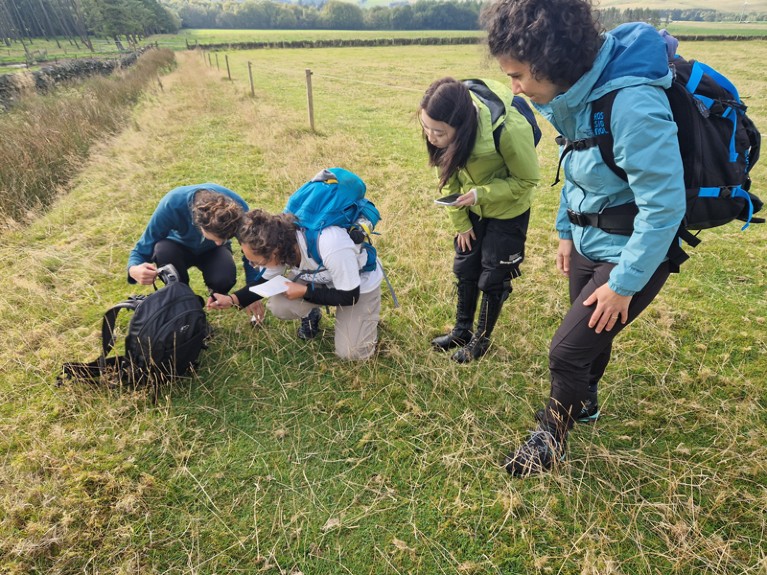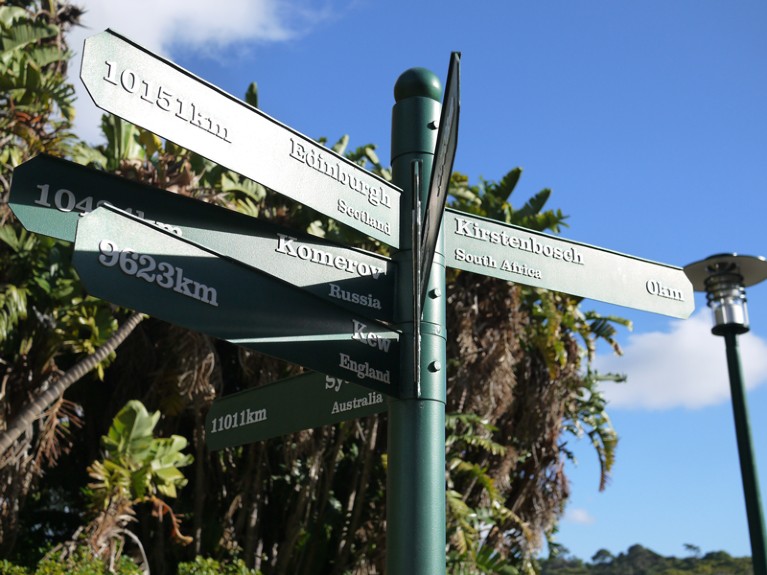Seeding an anti-racist culture at Scotland’s botanical gardens
Hidden figures haunt the archives of the Royal Botanic Garden Edinburgh (RBGE). They are the shadows of people whose contributions to the institute’s cornucopia of specimens have gone unrecognized. The archives contain, for example, exquisite drawings — some made by Indian illustrators centuries ago — of voluptuous pink lotuses, spindly legumes and delicate orchids. But, says Simon Milne, the public body’s chief executive and regius keeper, “we don’t know who those artists are”.
Today, such omissions speak volumes about the arrogance of white European explorers who, for most of the institute’s 350-year history, received the plaudits for building its vast collections of living and dried plants and historical botanical documents. But change is afoot at the RBGE, whose original site in the centre of the Scottish capital was founded in 1670, making it the second-oldest botanical garden in the United Kingdom; today, the garden is about 1.5 kilometres from the city centre and occupies 28 hectares. For the past two years, the institute — which has three other sites across Scotland — has accelerated its work to recognize the contributions of people who were not white Europeans and to make the gardens a more inclusive space to visit and work in.

Imperialism’s long shadow: the UK universities grappling with a colonial past
Such ambitions had existed before the murder in May 2020 of George Floyd, a Black man, by a white police officer in the United States. But it was that event and the global movement it sparked that precipitated a step-change in the gardens’ equality, diversity and inclusivity activities. In March, the institution published a racial-justice report that will feed into an action plan to “embed” racial-justice work as a “core aspect” of the organization. This extends to its research and training activities, with the report proposing dedicated PhD funds for students from minority backgrounds and promoting more equitable collaborations with scholars around the world. “We’re not rewriting history, we’re actually trying to tell the whole story,” says Milne.
Plant scientists of colour who follow these discussions are encouraged by the advances, but agree that much remains to be done. “There’s been a lot more inclusion of scientists of colour. There’s awareness. There’s effort,” says Nox Makunga, a South African botanist at Stellenbosch University who uses biotechnology techniques to study plants used in traditional African medicine.
Cynthia Fan, a PhD candidate at the University of Edinburgh, works at the RBGE’s Edinburgh site and helped to shape the racial-justice report, which she calls “a commendable framework of recommendations for a European botanical garden”. However, Fan, who has roots in South Africa and China, adds that “before RBGE can be considered anti-racist, it is crucial for the report to translate into tangible action”.
Plants and politics
With 280 permanent staff and close to 60 research associates, the RBGE trains master’s and PhD students in association with universities. Its living collections feature more than 13,000 plant species, and its herbaria house more than three million preserved plant specimens collected worldwide, the oldest being Crape Myrtle (Lagerstroemia) cuttings taken from South Africa more than 300 years ago.
Before Floyd’s murder, botanical gardens had largely escaped the scrutiny that had resulted in calls for museums to return cultural artefacts and human remains to their places of origin, says Caroline Lehmann, an ecologist at the University of Edinburgh. “Plants are viewed as apolitical, as something pretty you put in your garden,” says Lehmann, who also heads the RBGE’s tropical-diversity programme. However, a cursory look into the history of plant science shows this to be false. Crops associated with globalization, such as cotton, tobacco, coffee and rubber, were central to Europe’s projects of empire and slavery — as they were to slavery in the United States.

Master’s students carry out fieldwork for the Royal Botanic Garden Edinburgh, which plans to extend equity efforts to its training programmes.Credit: RBGE
“The exploitation of plants is closely linked to the exploitation of people,” says Lehmann, who led the working group that produced the racial-justice report and who is white. The report recognizes that the gardens’ present-day work is partially founded on collections and data deriving from “exploitative, colonialist, and racist activities”. It recommends that the gardens address the lingering legacies of this, which are visible today in the organization’s low representation of Black and Asian staff, volunteers and students. Only around 4{a57a8b399caa4911091be19c47013a92763fdea5dcb0fe03ef6810df8f2f239d} of the gardens’ staff identify as belonging to a non-white minority groups, and all work at the institution’s only urban site, in Edinburgh, where such groups make up 8{a57a8b399caa4911091be19c47013a92763fdea5dcb0fe03ef6810df8f2f239d} of the population.
Representation matters. “One of the challenges of doing this kind of self-searching exercise is that there’s not a great deal of diversity in our institution, especially at the senior levels,” says Milne, who ran the Scottish Wildlife Trust for a decade before joining the gardens. Appointed in 2014, he is the sixteenth regius keeper in the garden’s history, all of them white men. Focus groups, consisting of people from minority ethnic communities that have faced racism and discrimination in the United Kingdom, revealed that the lack of diversity among staff and volunteers made them feel unwelcome, both as visitors to the gardens and as potential employees. And only about 20{a57a8b399caa4911091be19c47013a92763fdea5dcb0fe03ef6810df8f2f239d} of the community groups that regularly engage with the gardens include people from minority ethnic backgrounds, the report found.
Milne admits that he did not fully fathom the historical links between botany and racism when the RBGE first embarked on its racial-justice work. He recalls telling his team early on that “at least we don’t have a statue or memorial that is of concern”. A colleague then pointed out that the Edinburgh garden’s central statue of Carl Linneaus could be considered just that. The eighteenth-century inventor of the system of classifying plants, animals and minerals espoused dividing the human species into racial ‘varieties’ characterized, in part, by skin colour and stereotypical temperaments. These notions underpinned racist science in the following centuries.

University of Cape Town’s battle to tackle a racist legacy
Although there are no plans to remove the statue from the gardens, widespread efforts have been made to contextualize the work of white plant collectors and highlight the contributions of people of colour. Informational texts now give more room to the origins of plants, their local uses and their cultural or religious significance. For example, a text that invited donors to “adopt” a Himalayan cedar (Cedrus deodara) growing at the Edinburgh garden described the plant as the national tree of Pakistan, with healing properties that have been recognized in India for 3,000 years, before noting that its ornamental beauty “has been appreciated in British gardens since 1831”.
Efforts to reimagine and recontextualize the gardens’ collections started before the racial-justice work of the past two years, but recent events have accelerated them. This year, in a series of guided trails, the gardens sought to engage visitors with Indigenous peoples’ perspectives on plants brought from overseas. Future exhibitions will highlight the garden’s hidden contributors, such as the nameless Indians whose art is in its archives. Those archives now also come with a warning that some of the records contain material that is “inappropriate, outdated, offensive or distressing”, and that does not reflect the gardens’ “current views and values”.
A thorny path
But publicly accounting for the ways in which the gardens have benefited from white supremacy and oppression was not without obstacles. Two weeks after Floyd’s murder, the RBGE, like many other institutions around the world, issued a statement in which it vowed to look at itself “critically, in the mirror”. That introspection, resulting in March’s report, took longer than expected, says Lehmann. “The more we got into this work, the more we realized how complex it was, and how involved it was.” It was essential that the process allowed ample time for reflection and conversations, particularly engaging formerly excluded groups and minorities. “You’ve got to bring in outside voices, and I think they come in many, many forms. If you don’t set aside the right space and foster the right conditions for that process, I think you’ll end up with something really superficial,” she says.
Getting outside perspectives was crucial to make up for the institution’s glaring lack of diversity. Both Milne and Lehmann praise the gardens’ PhD students — its most diverse group — for bringing crucial insights. Fan, who studies the genetics of begonia leaves, says that she initially had “low expectations” for a response from the RBGE following Floyd’s death. In 2015, she’d been in the second year of her master’s degree at the University of Cape Town in South Africa when the Rhodes Must Fall protests began. Driven by a desire to remove a statue of the British imperialist Cecil Rhodes from the campus, the campaign prompted conversations on institutional racism. “My department was predominantly white, and these discussions were immediately met with resistance, which felt incredibly disappointing,” she says.

This painting of rose moss (Portulaca grandiflora) from Dapuri, India, was made by an unknown artist between 1847 and 1850.Credit: RBGE
She was sceptical that her Edinburgh employer would do any better. So, she was pleased when the RBGE’s Racial Justice Working Group formed. However, after getting involved with the group’s work, she was reminded once more of the emotional burden that disproportionately affects scientists of colour, such as herself, when engaging with efforts to decolonize an institution. Fan began to study the history and power dynamics between China and the United Kingdom. “Researching colonial exploitations towards a race I identify with, while knowing that my workplace was linked to and still benefits from these exploitations, was unsettling,” she says. “It felt very conflicting,” she says — trying to understand the institution’s need for perspectives from people of colour while also resenting the toll that such work takes on them.
Of course, there are detractors, who say that the gardens are going too far, that they are pandering to fashionable identity politics and ‘wokeism’, says Milne. He himself doesn’t use the term ‘woke’, but he doesn’t think of it as a slur. If somebody uses that word to imply a “broader awareness of social injustice, then I am proud to be described as such”.
Yet the criticism faced by the RBGE over its decolonization plans pales in comparison with the media storm that its sister institution in London, the Royal Botanic Gardens, Kew, experienced after announcing its own plans.
After Floyd’s murder, Kew’s scientific director, Alexandre Antonelli, published an article outlining the institute’s ambition to “tackle structural racism in plant and fungal science”. Kew published ‘Our Manifesto for Change’ in March 2021, in which it vowed to “move quickly to ‘de-colonise’ our collections, re-examining them to acknowledge and address any exploitative or racist legacies, and develop new narratives around them”.

Is ‘decolonization’ losing all meaning?
Kew’s proposals were not dissimilar to those put forward by the RBGE. In fact, the two institutions are working together on their racial-justice programmes. Yet, Kew’s plans drew more ire, and from more-powerful people. Days after Kew published its manifesto, John Hayes, a Conservative member of the UK Parliament, called it “preposterous posturing” in an interview with the Daily Mail newspaper. Last December, the London-based right-wing think tank Policy Exchange published a report claiming that Kew was making “forays into non-scientific, and indeed politically charged, activities” that might contravene the National Heritage Act and violate the garden’s charter, calling into question its public funding.
Kew denies that re-examining the institution’s history is outside the scope of its mission. In a statement to Nature, Kew said it was continuing to work on issues to do with equity and inclusivity. A cross-disciplinary working group has examined Kew’s history, and its record on equity and inclusion, and its recommendations are being implemented. In October, Kew published an equity, diversity and inclusion delivery plan.
Various factors could explain why Kew’s plans were attacked so vocally, compared with those of the RBGE. Lehmann thinks that it is partly a matter of size: Kew is several times larger than the RBGE, with roughly 1,200 staff, and more than 350 scientists and 700 volunteers. But the racial and ethnic demographics of its staff — of whom 83{a57a8b399caa4911091be19c47013a92763fdea5dcb0fe03ef6810df8f2f239d} are white, 6{a57a8b399caa4911091be19c47013a92763fdea5dcb0fe03ef6810df8f2f239d} Asian and 1{a57a8b399caa4911091be19c47013a92763fdea5dcb0fe03ef6810df8f2f239d} Black — are similar.
She thinks that political differences between Scotland and the rest of the United Kingdom also played a part. Boris Johnson, the UK prime minister at the time of Floyd’s death, urged protesters to avoid planned Black Lives Matter demonstrations and the toppling of statues in UK towns and cities, tweeting: “We cannot now try to edit or censor our past.” Lehmann says that “there is a cultural war at play in the broader UK”. Such vehemence has been absent from Scottish public discourse, she notes.
Black botanists push for change
Beyond the efforts being made at specific gardens, work needs to be done on a global scientific level. Makunga co-founded Black Botanists Week, a global event to shine a light on Black and Indigenous scholars in botany and plant science. One of that community’s discussions, she says, is whether to rename plants whose scientific names are offensive to Indigenous people. For example, plenty of plants have the taxonomic name ‘caffra’, which derives from an Arabic expression that came to be used as an offensive term for Black people in southern Africa. “Those names have a terrible connotation,” says Makunga.
Changing racist nomenclature was one of the suggestions put forward by a group of staff members at Kirstenbosch National Botanical Garden in Cape Town in August 2020, a few months after Floyd was killed. The garden, established in 1913, is one of the oldest in Africa and is perched on land bequeathed by Rhodes. The garden, like many South African institutions, has a complicated history intertwined with colonialism and apartheid.

Like other famous botanical gardens, Kirstenbosch in Cape Town is at a crossroads of change.Credit: Wesley Fernandes/Nature
Phakamani M’Afrika Xaba, who is African and the principal horticulturist at Kirstenbosch, is one of the staff members who put forward the reform campaign, dubbed Faka Nathi (‘include us’ in the Nguni language). The plan was initially welcomed by the garden’s leadership team, he says, but he is disappointed with progress so far. The campaign proposed actions such as making the garden and its exhibits more accessible and relevant to poor and disadvantaged people, and removing offensive signage. “People are keen for change,” says Xaba, “they want change. But sometimes, senior people don’t welcome it — they see it as a threat.”
In a statement sent to Nature, the South African National Biodiversity Institute (SANBI), which manages all the country’s botanical gardens, says that it has created an internal group to address transformation activities, “including dealing with gender and racist stereotypes”, such as those identified by initiatives such as Faka Nathi. SANBI also said that the context in South Africa is different from that in other countries, in that the transformation approach is informed by a government-wide agenda. “All staff at Kirstenbosch are participating in a SANBI-wide transformation process which aims, among many other things, to reverse and undo racist legacies that manifest in various forms in the gardens,” it says.
For Xaba, there’s a long way still to go. For one thing, places such as Kew continue to hold many of the type specimens of plants that were found in South Africa. These are the first scientific samples of plant species, often dried and mounted with information about where and when they were collected. Botanists in developing countries might therefore have to travel to study these specimens, which remain the property of foreign institutions, Xaba explains.
“It’s those things that really worry people like me. We still have these very one-sided partnerships where we are the colony and natural resources are getting extracted, and people are publishing papers about our biodiversity. They still get economic benefits, and those don’t really trickle down,” he says. “It’s the culture that needs to change, and the whole system that needs to reboot.”
